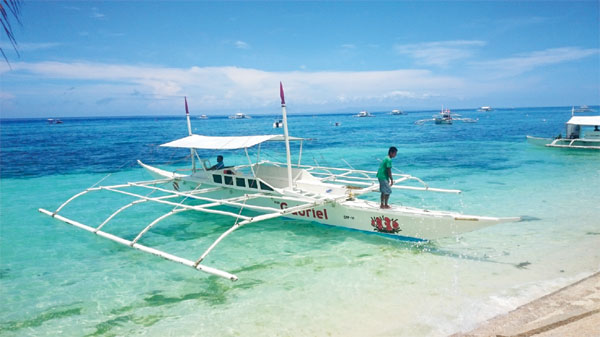
Boats dot the pristine waters of Bohol Island in central Philippines. Increasing numbers of mainland Chinese tourists are visiting the country, attracted by the spectacular natural scenery and abundant marine life. (ZHANG HAIZHOU/CHINA DAILY ASIA WEEKLY)
The Philippines is emerging as a more attractive destination for holidaymakers from the Chinese mainland despite geopolitical concerns, according to industry insiders.
Tour operators see the Philippines adopting more pragmatic policies, such as visa-free entry for Chinese citizens, to attract more tourists.
Ctrip, China's leading online travel agency, noted that the visitor numbers from the Chinese mainland to the Philippines have soared 200 percent in the last five months.
"Currently, we see an increasing number of Chinese tourists heading to the Philippines," Ctrip told China Daily Asia Weekly.
The Philippine archipelago — which is blessed with more than 7,000 islands, spectacular natural scenery and abundant marine life — has been welcoming rising numbers of Chinese tourists since mid-2015, Ctrip said.
Following the slump in tourism from 2012 to 2014, visitors from China increased 62.44 percent from 33,250 arrivals in April 2015 to 54,011 in April this year.
Visitors from China also secured the third spot with a count of 238,523 and a share of 11.5 percent in the first four months of 2016, according to a report by the Philippines' Department of Tourism.
According to research in April from the Hong Kong-based investment house CLSA titled, Great Wall of Chinese, arrivals to the Philippines from the Chinese mainland may outnumber tourists from traditional markets such as Japan and the United States in the next few years.
The catch-up in visitor numbers is good news for the Philippine economy, as tourism contributed 10.6 percent of the country's GDP in 2015, according to data from the World Travel and Tourism Council.
But the specter of a Beijing-Manila territorial dispute lingers and geopolitics still plays a big role in the number of Chinese tourists to the Philippines.
In recent years, the two countries' troubled geopolitical legacy has continued to impact the number of tourist arrivals from China to the Philippines. In 2014, China's Ministry of Foreign Affairs issued a travel advisory to Chinese nationals, citing violence against Chinese in the Philippines.
The travel industry now hopes that the new Duterte administration will improve relations between China and the Philippines and boost tourism.
"We hope the new Philippines president will launch more policies (that will benefit the) travel industry," Ctrip said. "We are hoping for visa-free access for Chinese tourists."
The online travel agency said the Philippines remains a favorite holiday destination for lovers of nature, adventure sports and beaches.
The CLSA report also noted that the number of Chinese visitors to the Philippines has seen the biggest year-over-year growth, leading other Asia-Pacific countries with a 130-percent gain.
Simon Shen Xu-hui, international relations scholar at the Chinese University of Hong Kong, said: "It is too early to tell, but because of (Duterte's) more pragmatic stand regarding China, it's likely that bilateral relations could improve in the future, especially at the civilian and business level. So could tourism."
According to CLSA, although it would be "naive" to assume a similar growth trajectory as the tourist numbers in Thailand for the Philippines, "the potential to grow here is higher than most other countries".
More than 8 million Chinese visited Thailand in 2015, and a total of more than 120 million Chinese traveled abroad last year, up 12 percent year-on-year, according to the Xinhua News Agency.
Though travelers from the Chinese mainland have begun to return to the Philippines, tour groups from Hong Kong are still staying away, six years after a deadly bus hijacking incident on Aug 23, 2010 killed eight tourists from the Chinese special administrative region.
The killings by the hijacker, a former Philippine police officer who was demanding his reinstatement, followed a botched rescue attempt, which was seen on a live telecast.
Bilateral relations between Hong Kong and Manila worsened when then Philippine president Benigno Aquino refused to offer an apology to the bereaved families of those killed in the incident. Consequently, Hong Kong put a black travel alert on the Philippines which was lifted only in April 2014 following a formal apology from the Philippine government.
Travel agencies from Hong Kong that used to specialize in packages to the Philippines said that although some individual tourists are venturing to the Philippines, many are still reluctant to join tour groups to the country.
Only 122,180 Hong Kong tourists visited the Philippines in 2015, according to the Tourism Promotions Board (TPB) in Manila.


















































